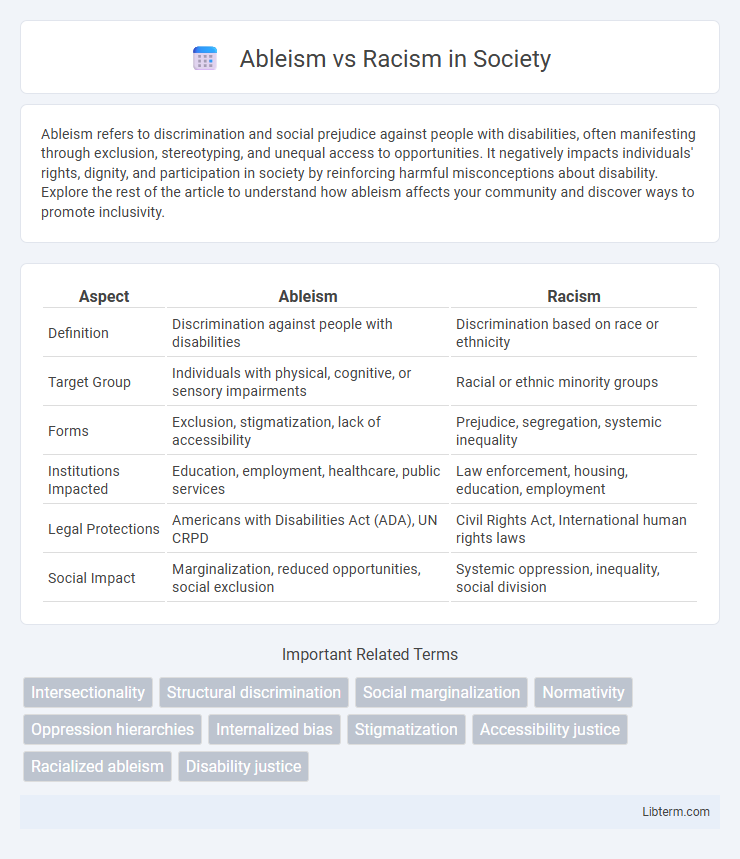Ableism refers to discrimination and social prejudice against people with disabilities, often manifesting through exclusion, stereotyping, and unequal access to opportunities. It negatively impacts individuals' rights, dignity, and participation in society by reinforcing harmful misconceptions about disability. Explore the rest of the article to understand how ableism affects your community and discover ways to promote inclusivity.
Table of Comparison
| Aspect | Ableism | Racism |
|---|---|---|
| Definition | Discrimination against people with disabilities | Discrimination based on race or ethnicity |
| Target Group | Individuals with physical, cognitive, or sensory impairments | Racial or ethnic minority groups |
| Forms | Exclusion, stigmatization, lack of accessibility | Prejudice, segregation, systemic inequality |
| Institutions Impacted | Education, employment, healthcare, public services | Law enforcement, housing, education, employment |
| Legal Protections | Americans with Disabilities Act (ADA), UN CRPD | Civil Rights Act, International human rights laws |
| Social Impact | Marginalization, reduced opportunities, social exclusion | Systemic oppression, inequality, social division |
Understanding Ableism and Racism: Definitions and Origins
Ableism refers to discrimination and social prejudice against people with disabilities, rooted in the belief that typical abilities are superior. Racism involves systemic oppression and bias based on race, originating from historical colonialism and slavery. Both ideologies perpetuate inequality by marginalizing groups through institutional, cultural, and interpersonal exclusion.
Historical Contexts: How Ableism and Racism Have Shaped Societies
Ableism and racism have historically structured social hierarchies by marginalizing disabled individuals and racial minorities through legal, economic, and cultural systems. Institutional policies like segregation laws and exclusionary education reinforced racial discrimination, while eugenics and medical discrimination perpetuated ableism. These intersecting oppressions have deeply influenced societal norms, access to resources, and collective identity formation over centuries.
Systemic Discrimination: Structures Supporting Ableism and Racism
Systemic discrimination manifests in both ableism and racism through institutional policies and societal practices that marginalize disabled individuals and racial minorities. Educational systems, employment opportunities, healthcare access, and legal frameworks often perpetuate inequalities by embedding biases that favor able-bodied and white populations. Addressing these structural barriers requires comprehensive reforms targeting discriminatory laws, resource allocation, and cultural norms to promote equity across disability and race intersections.
Intersectionality: When Ableism and Racism Overlap
Ableism and racism intersect uniquely, compounding discrimination for individuals with disabilities who belong to racial minorities. This intersectionality creates layered barriers in healthcare, employment, and social services, intensifying marginalization. Understanding the overlap is crucial for developing inclusive policies that address both ableist and racial biases simultaneously.
Societal Attitudes and Stereotypes: Influences on Behavior
Societal attitudes towards ableism and racism shape pervasive stereotypes that influence individual and institutional behavior, often marginalizing disabled and racially diverse groups. These stereotypes include assumptions about capability and worth, which perpetuate discrimination in employment, education, and social inclusion. Understanding the overlap and distinctions in these prejudices is essential for developing effective policies that promote equity and challenge systemic biases.
Language Matters: Ableist and Racist Terminology in Everyday Life
Ableist and racist terminology in everyday language perpetuates harmful stereotypes and reinforces social inequalities by marginalizing disabled individuals and racial minorities. Common phrases rooted in ableism and racism, such as using "crazy" to discredit mental health or racially charged slurs disguised as casual insults, contribute to systemic discrimination. Recognizing and challenging these terms is essential for fostering inclusive communication and promoting equity across diverse communities.
Impact on Individuals: Mental, Emotional, and Socioeconomic Effects
Ableism and racism both inflict profound mental and emotional distress, manifesting as anxiety, depression, and diminished self-worth among affected individuals. These forms of discrimination restrict access to education, employment, and healthcare, intensifying socioeconomic disparities and perpetuating cycles of poverty. The compounded impact undermines social inclusion and hinders mental well-being, leading to long-term adverse outcomes across marginalized communities.
Media Representation: Narratives of Disability and Race
Media representation of ableism and racism often reveals entrenched stereotypes that shape public perceptions of both disability and race. Disability narratives typically focus on pity or inspiration tropes, while racial narratives frequently emphasize criminality or exoticism, limiting authentic and diverse portrayals. Inclusive media practices that amplify the voices of disabled and racial minorities are essential to dismantling these harmful stereotypes and promoting nuanced understanding.
Advocacy and Allyship: Combating Ableism and Racism Together
Advocacy and allyship play crucial roles in combating ableism and racism by promoting intersectional awareness and inclusive policies that recognize the interconnected nature of discrimination. Effective allyship involves listening to marginalized voices, amplifying diverse perspectives, and supporting initiatives that address both accessibility barriers and racial injustices simultaneously. Collaborative efforts between disability rights organizations and racial justice movements foster solidarity, ensuring systemic change benefits all marginalized communities.
Moving Forward: Building Inclusive and Equitable Communities
Building inclusive and equitable communities requires actively addressing ableism and racism by implementing policies that ensure equal access to education, employment, and healthcare for all individuals. Promoting awareness and empathy through community programs and diversity training fosters a culture of respect and understanding, reducing discrimination and social barriers. Collaborative efforts between policymakers, advocacy groups, and local organizations are essential to create systemic change that upholds the rights and dignity of marginalized populations.
Ableism Infographic

 libterm.com
libterm.com